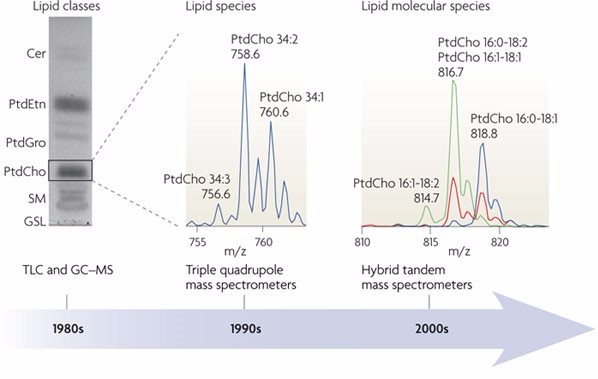Lipids are the main components of biological membranes. They are not only a major form of energy storage in living cells, but also well-known cell signaling mediators.
The lipidome is composed of eight major categories, more than 80 major classes, 300 sub-classes, and thousands of lipid species with various concentrations. Lipidomics is the systematical study of all lipid molecules (>30,000 individual species) within a biological system, tissue, fluid or cell. To understand cellular physiology and pathophysiology well, comprehensive identification and precise quantification of lipids is crucial in lipidomics research.
Untargeted lipidomics makes it possible to analyze hundreds to thousands of individual lipid species simultaneously, which is valuable to evaluate an individual's health status. Differences in lipid profiles have been reported in investigations of cancer, diabetes, Alzheimer's disease and cardiovascular disease. Such amounts of detailed lipid profiles are available to assess medical risks, monitor and optimize patient treatments and are the basis for the concept of precision medicine. Applications of untargeted lipidomics include agro science, biomarkers, Alzheimer's, atherosclerosis, cardiovascular, cancer, diabetes and obesity disease research, drug discovery and systems biology.
 Figure 1. Analytical technologies for understanding the lipidome molecular complexity (Nature Review, Molecular Cell Biology)
Figure 1. Analytical technologies for understanding the lipidome molecular complexity (Nature Review, Molecular Cell Biology)
Though lipid is a major part of the metabolome, the insolubility of many lipids in aqueous solutions makes it is necessary to use different methods from that for more water-soluble components of the metabolome. Mass spectrometry (MS) is the dominant platform in lipidomics, while nuclear magnetic resonance (NMR) has been used wildely in metabolomic studies. Gas chromatography (GC)–MS was a major tool for lipid profiling studies in the past. However, this technology has been replaced by the interfacing of desorption ionization techniques of atmospheric pressure ionization (API) and matrix-assisted laser desorption/ionization (MALDI) with MS. API, usually electro- spray ionization (ESI), is often linked to a liquid chromatography (LC) system for separation prior to MS analysis. MALDI is mostly performed under vacuum and is not usually linked to LC separation, while MALDI can be performed from thin-layer chromatography (TLC) plates. MALDI –MS imaging (MSI) is becoming a more and more adopted technology in lipidomics, which can provide spatial information to lipid classes in tissues. Through measurement of the mass-to-charge ratio (m/z) of ionized species, MS gives molecular weight information. Many modern MS instruments can offer mass accuracy at a level of 0.001–0.002 m/z, which allows m/z searches against the Lipid Maps database of compounds or identify ionized molecules through various commercial or open-source software. Tandem mass spectrometry (MS/MS) or multistage fragmentation (MSn) experiments can give structural information.
Our Untargeted Lipidomics Service
With integrated set of separation, characterization, identification and quantification systems featured with excellent robustness & reproducibility, high sensitivity, Creative Proteomics provides reliable, rapid and cost-effectiveUPLC-Q-TOF untargeted lipidomics services. A detailed technical report will be provided at the end of the whole project, including the experiment procedure, MS/MS instrument parameter. Data analysis of the results and raw data is also available upon request.
Application
1. Identification of lipid substances in biological samples;
2. Research on lipid function and metabolic regulation;
3. Lipid metabolism pathway and network research;
4. Discovery of lipid biomarkers.
Sample Preparation
Lipids can come from variety of sources.
Extraction Of Lipids
Lipids can be extracted from any kind of organism, tissue or cell types using a mixture of chloroform/methanol/water or methyl tert-butyl ether-based extraction. Once extracted samples are centrifugated.
Transfer For Analysis
Samples are transferred to a 96-well plate or sample vials and lyophilized. They are then reconstituted in organic solvent for direct infusion. Or ready for LC-MS experiments.
Analysis By Direct Infusion or LC-MS/MS
Lipids are analyzed by direct infusion MS/MS,MS or LC-MS/MS,LC-MS on Orbitrap-based mass spectrometers.
Automated Data Analysis
Lipids are identified and quantified using HRAM MS,MS/MS or MS data using LipidSearch software.
Workflow of Untargeted Lipidomics

Technical Advantages
1. Massive database: LipidSearch database, which contains spectra of more than 8 categories, 300 subcategories, and 1.7 million lipid molecules;
2. High qualitative ability: the average identification number of projects is greater than 3,000, and the highest identification number exceeds 5,000;
3. Method advantages: QE series high-resolution mass spectrometry is combined with high-efficiency chromatography to achieve high-throughput detection;
4. Strict quality control: adopt the most stringent QC system to ensure that the qualitative and quantitative results of each project are excellent.
Sample Requirement
| Sample Type | Normal Sample Volume | Minimum Sample Volume | |
|---|---|---|---|
| Cell | Cell | ≥ 107 | ≥ 107 |
| Animal tissue | Liver, kidney, etc. | ≥ 100 mg | ≥ 60 mg |
| Body fluids | Plasma/serum, cerebrospinal fluid, etc. | ≥ 200μL | ≥ 100μL |
| Special samples | Please inquire separately | ||
Data Analysis
| Type of analysis | Analysis content | Problem to be solved |
|---|---|---|
| Quality control | TIC, OC, etc. | Obtain high quality data |
| Profile | Superclass | Obtain classification information |
| Difference analysis | Univariate statistical analysis (volcano plot, etc.) | Reflects between-group differences for each variable |
| Multidimensional statistical analysis (PCA, PLSDA, OPLSDA, etc.) | Assess the difference between groups and find the influencing variables that lead to the difference between groups | |
| Functional analysis | hierarchical cluster analysis | Obtaining expression pattern information for metabolites |
| Correlation analysis | Measures the degree of correlation between two variables | |
| KEGG analysis | Learn more about relevant metabolic pathways and functions | |
| Advanced analysis | Regression analysis | Establish associations between important metabolites and other indicators |
| Trend clustering analysis | Exploring the trend pattern of metabolite levels | |
| Machine learning | Screening for biomarkers with good diagnostic performance |
How to place an order

*If your organization requires signing of a confidentiality agreement, please contact us by email.






